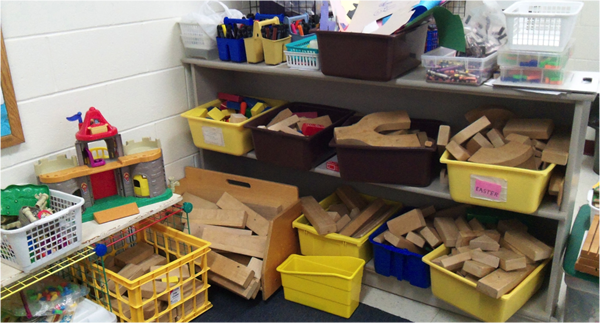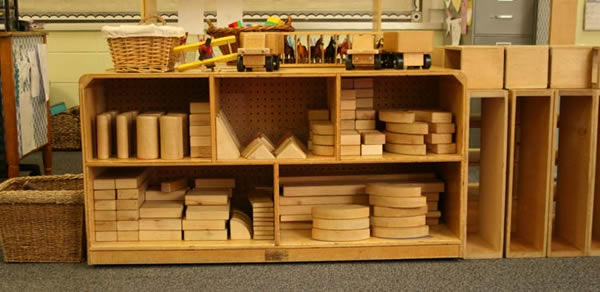Lesson 9: Enironments: Materials


Learning Outcomes
Upon completion of this lesson's material students will be able to:
- Identify materials needed in each interest area
- Work within a realistic budget
- Discuss the importance of a wide variety of materials
Teaching
Now that the environment is set with defined areas it is time to make some purchases. Here is a list of things to consider:
- What needs to be placed on the shelves?
- How do I find the items I am looking for?
- Do I have enough books and other literacy materials?
- Do I have materials to cover children’s home culture and many other cultures?
- The many components of diversity?
- Multi-generational items?
- Math?
- Science?
- Creativity?
- Motor development?
- Social and emotional development?
- Will the items I have chosen expand and extend children’s interest and discovery?
- Where do I store all this stuff?
Oh no, I forgot to consider:
- Office items
- Medical supplies
- Cleaning supplies
- and who knows what else!!
Now that I have thought about all these things– How can I get the most bang for my buck and stay within my budget?
- Where can I find the materials I am looking for?
- Is it okay to buy things at yard sales or consignment shops?
- Do I purchase all Name Brand items or is the quality of the mark-offs just as good?
These are all the thoughts that need to be considered. Now let’s create a Wish List of items to purchase:
Essentials: (enough for each child and adult in the program plus a couple of extras for volunteers or family members)
- Child-sized tables and chairs
- Cubbies –
- Mats or Cots for rest time
- Storage cabinet with a lock for toxic cleaning materials
Block Area:
- Storage Shelf’
- Containers for props (animals, vehicles, dinosaurs)
- Carpet (to absorb sound)
- 1 large set of Unit Blocks
- Multi-ethnic families
- Community workers or career people and their vehicles
- Cars and trucks (various sizes)
- Traffic signs and road maps
- Large and small animals (ocean, farm, forest, jungle, arctic, dinosaurs)
- Wooden train and track
- A Variety of other blocks (alphabet, bristle blocks, Lincoln logs, colored blocks, tabletop blocks, large hollow blocks)
Click HERE to learn about the Developmental Stages of Block Play!
Dramatic Play Area
- Kitchen set – stove sink refrigerator hutch
- Small table with 4 chairs
- Multi ethnic dolls with clothing, bed or cradle, high chair
- Child sized dishes, pots and pans, silverware, cooking utensils, plastic food
- Unbreakable Mirror
- Dress-up clothes with appropriate variety for boys and girls
- Writing materials and implements/phonebooks/menus/cookbooks/newspapers/magazines
- Containers to keep items organized
- Prop boxes for farm, fire safety, costume shop, harvest, grocery store, post office/mail carrier, hospital/doctors./dentist, pet store/veterinary, restaurant, camping etc.)
Something to think about: Why is important to have multiple prop boxes available?
Creative Area
- Storage shelf
- Table and chairs
- 2 (min) paint easels
- Various size and thickness paint brushes
- Paint smocks, paints and cups with lids
- Paint drying rack or string with clothes pins
- Child size scissors (regular, looped, right hand, left hand, stationary)
- Various types of paper (construction, lined, blank) and varied thicknesses as well
- Chalk and chalk boards with erasers
- Lap Boards with dry erase markers with erasers
- Glue, Glue Sticks, scotch tape
- Playdough with cutters and tools
- Writing utensils (markers, colored pencils, crayons, pencils – all of various thicknesses and lengths)
- Stamp pads and stampers
- Water colors and brushes small table and chairs
Something to think about: Why is it important to provide children with a wide variety of art materials and media to explore and manipulate?
Manipulatives Area
- Storage shelf
- Small table and chairs
- Magna tiles or similar item
- Legos and flat boards
- Unifix cubes
- Counting cubes
- Snap blocks or bristle blocks
- Gearopolis
- Tinkertoys
- Natural Tree Blocks
- Marbles for counting
- Clothespins
- Geoboards with elastics
- Pegs and Peg Boards
- Sorting Trays
- Variety of puzzles
- Lacing and stringing beads
- Nuts and Bolts
- Nesting toys
- Locks and latches
- Memory games
- Floor puzzles
- Pattern blocks w/ picture cards
- Candyland/Chutes and ladders/Bingo
- Card games – Go Fish, Old Maid, Uno, SkipBo
Something to think about: What do you do when you notice a child is having difficulty with cutting, drawing, lacing and stringing?
Literacy Area
- Book Display Shelf
- Pillows/cushions/bean bag chairs
- Mat or carpeting
- Assorted Books
- Flannel Board with story sets
- Additional books to cover seasonal and multiple annual themes
- Books on CD with audio player
- Big Books
- Various Puppets
- Social Stories
Something to think about: How will you meet the needs of a child who home language is not English?
Click HERE to learn more about reading out loud to preschoolers
Discovery Area
- Storage or display shelf
- Color paddles
- Binoculars and magnifying glasses
- Magnets
- Collection of natural objects
- Plants fish or pet
- Balance scale
- Prisms kaleidoscopes
- Bug house ant farm
- Mirror trays
- Sink and float items
- Science books and games
Something to think about: A child is afraid of spiders. His family does not want you to put out your spider display. How will you respond to this family?
Click HERE to see a few ideas about dealing with young childrens' anxieties.
Music and Movement Area
- Storage shelf or wall hanger to display instruments
- CD player with a wide variety of musical CD’s
- Rhythm instruments
- Drums
- Dance and movement props
- Rhythm sticks, bells, shakers drums tambourines
- Multicultural instruments
Something to think about: Should musical instruments be available throughout a day or only brought out occasionally? Why?
Click HERE to read an article about 18 Benefits of Playing a Musical Instrument
Sensory Area
- Sand/water table with a lid
- Waterproof smocks
- Spoons scoops ladles egg beaters sieves funnels basters
- Water wheels and pumps
- Vehicles animals
- Pinecones with needles Brussel sprouts pumpkins and other items from nature
- Beads and strings for lacing
- Various powders and textures for manipulation
Something to think about: How can I get a wide variety of materials donated?
ASK families to bring in items that are close to date or outdated or items they pick up on vacation
Technology Area
- Child sized computer desk, chair, computer, monitor, keyboard, mouse, mouse pad, printer, earphones
- Age appropriate software programs or CD’s
Something to think about: A family asks you to recommend some games for their child to play. What would you recommend?
Outdoor Area
Storage container
- Climbing strictures
- Balancing structures
- Ride-on toys – balance bikes, tricycles, wagons, scooters
- Traffic signs and cones
- Hard surface riding track
- Jump ropes, hula hoops, parachute, balls
- Gigantic Building materials
- Sand box with cover, buckets, shovels, scoops, dump trucks excavators, sieves, molds
- Water play area
- Easels or plexiglass on fence – paint brushes, squirt bottles
Something to think about: How do you explain to families why they need to bring appropriate outdoor clothing for their child to play outside daily?
Click HERE to read an article called "Why children need to play outside - even during the winter months" (This is a good article to share with parents.)
Making it Happen
Now the Wish List is compiled. How do I purchase everything I need and stay within the projected Budget?
- Compare prices at various websites: Discount School Supply, Kaplan, Lakeshore, Rifton etc…
- Shop at yard sales, Consignment Shops or Children’s Second Hand Stores
- Watch for area family child cares or centers closing in your area
- Look for local cooperatives or websites that sell items of interest in your area www.facebook.com/everythingkids
- Check with area businesses when their name or address changes. All of their stationary needs to be thrown away or recycled. Many are more than willing to find someone that will use it
- Ask families – I am always amazed at the stuff they are willing to donate or solicit
Next Step: Please think about the following:
- Do the environment and materials keep children healthy and safe?
- Are all materials organized to facilitate meaningful child engagement?
- Is there sufficient labeling for children to know where items are returned when they are finished playing?
- Are cleaning supplies readily available for teacher access when needed yet, locked so children do not have access?
Watch the following video and notice if anything is missing...
Assessment
Lesson 9 Assignment
You have been awarded a five thoughsand dollar grant. With the money, you have to purchase items that will enhance the learning areas of your classroom. You must choose five areas (reading, science, technology, sensory, art, manipulatives, block, dramatic play, gross motor, music/movement) to enhance and consider the following when purchasing your materials:
- Is the material age apprpriate?
- Is the material culturally sensitive?
- Does the material meet the goal and philosophy of your program?
- Do you have enough of the material?
Your report out on the money spent must include
- Item
- What company you purchased the item from
- Cost
- What areas it promotes/purpose of the material
Your format may look something like this.....
Item |
Vendor |
Cost |
Purpose/Area |
|
|
|
|
Tissues |
Walmart |
.96 |
Kids need to blow their nose. I will put a box in EVERY area to avoid boogers on clothing |
hand sanitizer |
walmart |
.58 |
Kids need to sanitize hands after blowing nose - |
Lesson 9 Discussion
Why is important to look at such a wide variety of classroom materials?